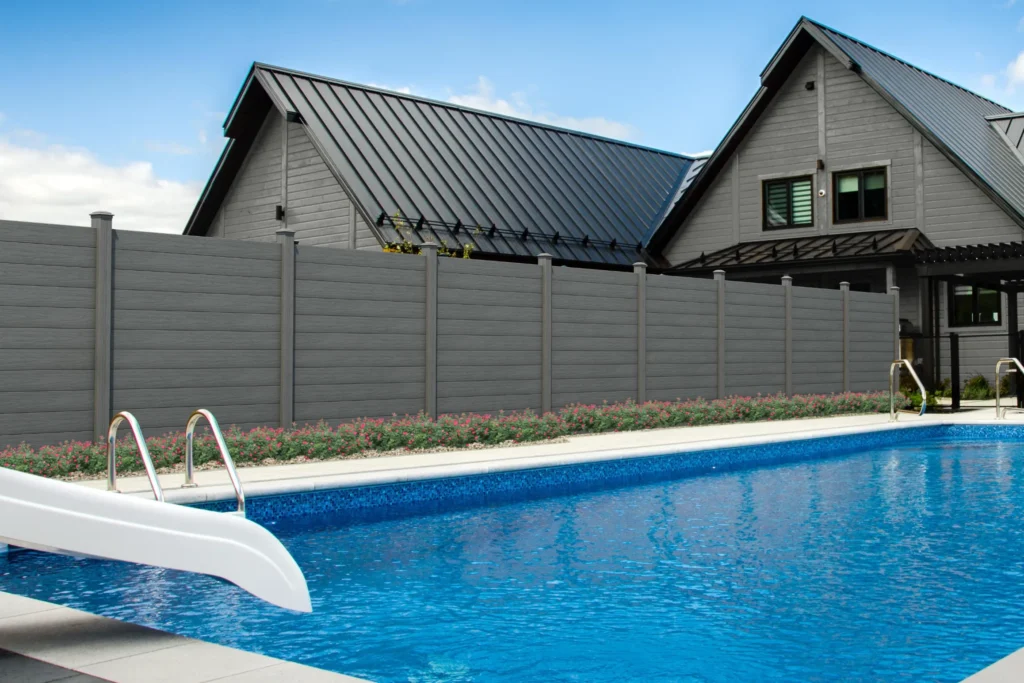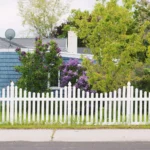If you’re exploring low-maintenance, long-lasting fencing options, composite fencing might just be what you need. Known for its durability, style, and eco-friendliness, composite fencing has become a go-to choice for homeowners who want the look of wood without the upkeep.
In this article, we’ll walk you through what composite fencing is, how it’s made, the benefits and drawbacks, and where it’s best used—so you can decide if it’s right for your yard.
What Is Composite Fencing?
Composite fencing is a type of fence material made by blending wood fibers (like sawdust or wood chips) with recycled plastics and bonding agents. The result is a dense, sturdy material that mimics the natural appearance of wood but performs more like plastic when it comes to moisture resistance and durability.
Composite fence panels are typically available in a range of colors, finishes, and styles—from horizontal slat designs to privacy panels with decorative top rails. Many products are designed to interlock, making them easy to install and suitable for DIYers or professional contractors alike.

How Is Composite Fencing Made?
The manufacturing process for composite fencing begins with collecting reclaimed wood materials and recycled plastics—often polyethylene or polypropylene. These raw ingredients are mixed with colorants, UV inhibitors, and other additives, then heated and pressed into boards or panels.
There are two main types of composite fencing:
- Co-extruded (capped): This includes a protective outer layer (or cap) that improves fade resistance and moisture protection.
- Uncapped: More affordable but slightly less resistant to staining and UV damage.
The final product looks a lot like wood but feels denser, smoother, and heavier—giving it a modern yet natural appearance.
Benefits of Composite Fencing
Composite fencing is popular for a reason—it offers several practical and aesthetic advantages, including low maintenance, long lifespan, consistent appearance, eco-friendly, and modern curb appeal:
Low Maintenance
Unlike wood, composite doesn’t need to be stained, painted, or sealed. A simple hose-down or mild soap wash once or twice a year will keep it looking great.
Long Lifespan
Thanks to its synthetic components, composite fencing resists rot, termites, warping, and splintering. Many manufacturers offer warranties of 20 years or more.
Eco-Friendly
Most composite fences are made using recycled materials. If sustainability matters to you, composite fencing helps reduce landfill waste while still providing a durable solution.
Consistent Appearance
Because it’s manufactured, every board is uniform in size and color. That means no knots, cracks, or defects to worry about.
Modern Curb Appeal
With clean lines and a sleek finish, composite fencing can give your property a high-end, modern look. Some brands even offer wood grain textures that mimic the real thing without the hassle.
Drawbacks of Composite Fencing to Consider
Despite its benefits, composite fencing isn’t perfect. Here are a few downsides to keep in mind:
Higher Upfront Cost
Composite is more expensive than pressure-treated wood or vinyl. However, its long-term savings in maintenance and replacements often make up for the initial investment.
Limited Color Changes
You can’t easily repaint or re-stain composite materials. What you buy is what you get—so make sure to choose a color and finish you’ll love for years.
Heavier Material
Composite panels are denser than wood or vinyl, making installation slightly more labor-intensive. You may need help lifting and placing the boards during setup.
Where Is Composite Fencing Best Used?
Composite fencing is highly versatile and works well in a variety of settings:
- Privacy Fences: Ideal for backyard enclosures or around patios where you want both seclusion and style.
- Garden Borders: Smaller panels can be used for raised beds, landscape divisions, or decorative edging.
- Sound Barriers: The density of composite material helps reduce noise—great for homes near roads or busy areas.
- Pool Enclosures: Its resistance to water and humidity makes it a smart choice around pools or spas.
Composite Fencing vs. Other Fence Materials
Here’s a quick comparison between composite fencing and more traditional options:
| Feature | Composite | Wood | Vinyl |
| Maintenance | Low | High | Low |
| Lifespan | 20–30+ years | 10–15 years | 20+ years |
| Appearance | Wood-like, uniform | Natural, varied | Smooth, plasticky |
| Eco-Friendliness | High (recycled) | Medium | Medium |
| Cost (Initial) | High | Low to Medium | Medium |
| Paint/Stain Friendly | No | Yes | No |
Final Thoughts: Is Composite Fencing Right for You?
If you’re looking for a durable, attractive fence that doesn’t demand constant upkeep, composite fencing is a solid investment. While the upfront cost may be higher, the long-term payoff—less maintenance, greater longevity, and lasting curb appeal—makes it worth considering for most homeowners.
Whether you want to create a peaceful backyard retreat or a stylish boundary line for your property, composite fencing delivers on both performance and aesthetics.


